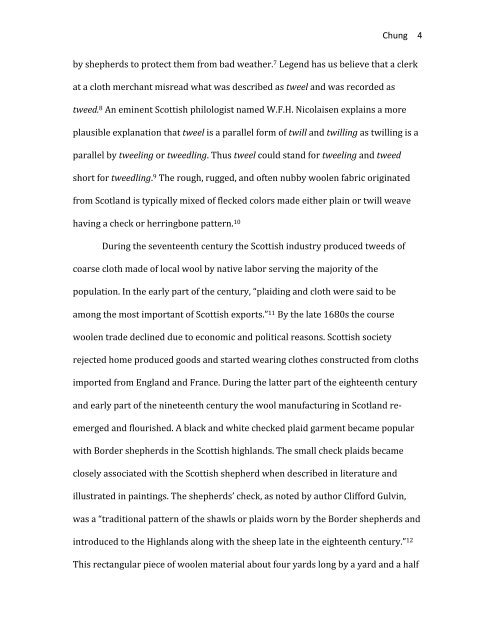Houndstooth - Imprint (NYC)
Houndstooth - Imprint (NYC)
Houndstooth - Imprint (NYC)
Create successful ePaper yourself
Turn your PDF publications into a flip-book with our unique Google optimized e-Paper software.
Chung<br />
by shepherds to protect them from bad weather. 7 Legend has us believe that a clerk<br />
at a cloth merchant misread what was described as tweel and was recorded as<br />
tweed. 8 An eminent Scottish philologist named W.F.H. Nicolaisen explains a more<br />
plausible explanation that tweel is a parallel form of twill and twilling as twilling is a<br />
parallel by tweeling or tweedling. Thus tweel could stand for tweeling and tweed<br />
short for tweedling. 9 The rough, rugged, and often nubby woolen fabric originated<br />
from Scotland is typically mixed of flecked colors made either plain or twill weave<br />
having a check or herringbone pattern. 10<br />
During the seventeenth century the Scottish industry produced tweeds of<br />
coarse cloth made of local wool by native labor serving the majority of the<br />
population. In the early part of the century, “plaiding and cloth were said to be<br />
among the most important of Scottish exports.” 11 By the late 1680s the course<br />
woolen trade declined due to economic and political reasons. Scottish society<br />
rejected home produced goods and started wearing clothes constructed from cloths<br />
imported from England and France. During the latter part of the eighteenth century<br />
and early part of the nineteenth century the wool manufacturing in Scotland re-‐<br />
emerged and flourished. A black and white checked plaid garment became popular<br />
with Border shepherds in the Scottish highlands. The small check plaids became<br />
closely associated with the Scottish shepherd when described in literature and<br />
illustrated in paintings. The shepherds’ check, as noted by author Clifford Gulvin,<br />
was a “traditional pattern of the shawls or plaids worn by the Border shepherds and<br />
introduced to the Highlands along with the sheep late in the eighteenth century.” 12<br />
This rectangular piece of woolen material about four yards long by a yard and a half<br />
4


